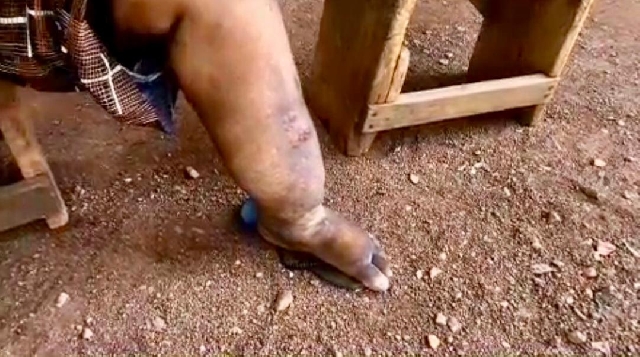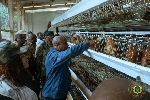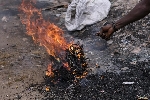Struggling in poverty: Widows confronted with elephantiasis in Talensi
 The affected leg
The affected leg
The scorching sun at Tongo market does little to hide Rita’s swollen leg. For ten years, the woman in her late 30s has endured the unbearable weight of elephantiasis, a disease that has robbed her of mobility, livelihood, and dignity.
Once a thriving trader with her own stock of goods, Rita, not her real name now relies on selling items on credit and paying back later. The disease has stripped her of independence, forcing her into a cycle of financial struggle and emotional pain.
Her situation worsened a year ago when she lost her husband, leaving her alone to provide for seven children.
“Sometimes I don’t even know where the next meal will come from.
With seven children to feed, buying uniforms, books; it is just too much for me to carry.
Look at my leg, walking is difficult sometimes. After some time, the pain becomes unbearable,” she said, her voice heavy with despair.
Despite the pain, Rita continues her daily trips to the market because her children must eat.
At first, she believed her condition was spiritual.
“I thought I had been cursed. Because you wake up one morning and see your leg swelling, what would you think?” she quizzed.
Her understanding changed only when the Development Research and Advocacy Centre (DRAC), an NGO working in Talensi, began educating women about neglected tropical diseases. Rita learned she was suffering from elephantiasis, a condition caused by parasitic worms transmitted by mosquitoes.
With this knowledge, she said she began seeking medical care, but the treatment is far beyond her financial reach.
“The medicines help, but even the small things nurses ask me to buy, I cannot afford. Soap for washing the leg daily, painkillers, other drugs… look at my table in the market, can I buy those when my children are starving?” she lamented.
She indicated that the competing demands of medical costs and childcare make it nearly impossible for her to continue treatment.
Like Rita, Madam Ayine, who once owned her merchandise but now survives on credit. “When customers see my leg, some walk away without buying,” she said softly, glancing at the swollen limb that has slowed her mobility and dampened her business.
According to her, her husband passed away seven years ago, leaving her to raise their children alone.
Her eldest daughter has just completed the Basic Education Certificate Examination (BECE), and Ayine is determined to send her to Senior High School. Yet with illness and dwindling income, the dream feels increasingly distant.
“I have gone to the hospital several times, but when the doctor writes medicines, I cannot buy them,” she said.
Like Rita, she attends DRAC’s sensitisation meetings, which give her hope, but treatment remains unaffordable.
The Bigger Picture
Globally, the World Health Organisation estimates that 120 million people live with lymphatic filariasis, mostly in poor rural areas.
In 2023, approximately 36 million people in Africa were estimated to live with the chronic condition of elephantiasis (lymphatic filariasis), with 657 million people in 39 countries at risk of infection
Although Ghana has made progress through mass drug administration programs, only about 18 percent of rural residents recognise elephantiasis as a disease.
Low awareness delays treatment, while stigma forces many into silence.
The Upper East Region recorded 2,373 confirmed cases in 2022, and by 2024, northern Ghana saw cases rise by 1.7 per cent.
In Talensi, the burden falls disproportionately on women, who already face economic hardship.
According to Derrick Aboyinga, a Disease Control Officer in Talensi, 155 people were diagnosed with elephantiasis in the district last year, of whom 138 were women.
Elephantiasis, or lymphatic filariasis, causes severe swelling of body parts, often the legs. Beyond the physical pain, it strips women of mobility, economic independence, and dignity.
“Elephantiasis is not just a disease, but a stigma,” explained Mary Nyaaba, a Health Promotion Officer in Talensi. Misconceptions worsen the suffering of patients. In many communities, the disease is still believed to result from curses or immoral behaviour.
Women with the condition often face ridicule, abandonment by spouses, and exclusion from social and economic life.
Breaking the Stigma
For many years, elephantiasis was widely believed to be a curse from the gods or the result of an individual’s wrongdoing. Because it was seen as incurable, this perception often left survivors neglected, ridiculed in public, and their families stigmatised with shame.
However, organisations like DRAC are working to change such deeply rooted misconceptions.
For close to a decade, with support from Fundación Anesvad, DRAC has been collaborating with District Health Management Teams in four districts, including Talensi in the Upper East Region, to strengthen the fight against skin-related Neglected Tropical Diseases (NTDs).
The organisation actively engages Community Health Management Committees (CHMCs) across 20 communities to ensure early detection of cases, link affected persons to quality healthcare, and raise awareness to reduce stigma and discrimination through the use of local languages and relatable analogies.
Jonathan Adabre, Executive Director of DRAC, said their mission is to demystify elephantiasis through education and advocacy.
“We want people to know it is not a curse. It is a disease, and it can be managed,” he emphasised.
Through their engagements, women like Rita and Ayine can seek treatment and reclaim confidence.
But treatment is not free, and for widows struggling to feed their children, the costs remain overwhelming.
Human Toll
For Rita, every day is a battle between the pain in her swollen leg and the determination to provide for her children.
Her once vibrant stall has shrunk to a modest table of borrowed goods. Her dignity has been bruised, but not her resilience.
For Ayine, the rejection she feels when customers avoid her stall is as painful as the disease itself.
She dreams of sending her daughter to school, but illness and poverty force her to choose between survival and hope.
Their struggles reveal a silent crisis: neglected tropical diseases like elephantiasis entrench poverty and despair in rural Ghana. Without stronger support for morbidity management, disability prevention, and financial aid for treatment, women like Rita and Ayine will continue to sink deeper into poverty.
A Call for Action
Health experts emphasise the importance of early reporting, mass drug administration, and community education to combat elephantiasis.
But equally urgent are policies that support women economically, enabling them to afford treatment and rebuild their livelihoods.
For now, Rita, Ayine, and many other victims cling to hope that one day treatment will be within their reach, that their children will not inherit the stigma, and that elephantiasis will be seen not just as a disease, but as a humanitarian crisis demanding urgent action.
Source: Classfmonline.com/Moses Apiah
Trending Features

Stop letting Maths and Science decide Ghana’s future
13:56
President Mahama’s agro-industrial revolution: Turning Ghanaian farms into business powerhouses
12:19
Laud Nartey: Growing unethical behaviour among bank staff- why BoG, GAB must scale up surveillance
07:02
Trapped in a cycle of danger: blood in the recycling factory
12:23
A new Africanism is rising: Why identity matters now
09:26
Kumasi High Court gripped by battle over Daddy Lumba’s widowhood rites
09:13
Drop in WASSCE 2025 performance – Reality check and opportunity for correction?
09:45




